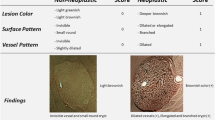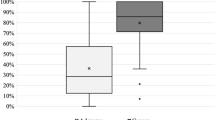Abstract
Background
There is little data on the prevalence of residual neoplastic tissue or the rate of endoscopically detected recurrence in patients with prior surgical or endoscopic resection of advanced neoplasia.
Aims
To compare standard white light with NBI for both the detection, as well as the differentiation, of residual or recurrent neoplastic tissue during real-time endoscopy.
Methods
A prospective study of 46 consecutive patients undergoing surveillance colonoscopy or upper endoscopy was conducted. Prior resection sites were examined first with white light and then with NBI. Main outcome measurements included the number of distinct lesions identified with white light, the number of additional lesions identified with NBI, and the overall accuracy of endoscopic diagnosis using white light alone or with NBI.
Results
Sixty discrete lesions were identified, 43 with white light alone, and an additional 17 with NBI. NBI identified more lesions per patient than white light alone (mean 1.33 vs. 0.96, p < 0.05) and there was a trend towards increased detection of neoplastic lesions. Recurrent/residual neoplasia was present in 14 patients (30%) and there was a trend towards increased detection with the addition of NBI. About 63% of lesions identified with white light appeared more extensive when examined with NBI. The diagnostic accuracy in predicting histology was equivalent for NBI and white light (87 vs. 88%), though there was a trend towards higher sensitivity for neoplastic lesions with NBI (88 vs. 69%, p = 0.16).
Conclusions
A substantial number of patients undergoing surveillance endoscopy had residual or recurrent neoplastic tissue identified at the prior resection site. As NBI detected additional neoplastic lesions as well as demonstrated that lesions detected with white light were more extensive, adjunctive use of NBI for examining post-endoscopy resection sites should be studied in future, larger studies.


Similar content being viewed by others
References
Risau W. Mechanisms of angiogenesis. Nature. 1997;386:671–674.
Sano Y, Kobayahi M, Hamamoto Y, et al. New diagnostic method based on color imaging using narrow band imaging (NBI) system for gastrointestinal tract. Gastrointest Endosc. 2001;53:AB125.
Gono K, Obi T, Yamaguchi M, et al. Appearance of enhanced tissue feature in narrow-band endoscopic imaging. J Biomed Opt. 2004;9:568–577.
Hirata M, Tanaka S, Oka S, et al. Evaluation of microvessels in colorectal tumors by narrow band imaging magnification. Gastrointest Endosc. 2007;66:945–952.
Sano Y, Ikematsu H, Fu KI, et al. Meshed capillary vessels using narrow band imaging for differential diagnosis of small colorectal polyps. Gastrointest Endosc. 2009;69:278–283.
Robertson DJ, Greenberg ER, Beach M, et al. Colorectal cancer in patients under close colonoscopic surveillance. Gastroenterology. 2005;129:34–41.
Farrar WD, Sawhney MS, Nelson DB, et al. Colorectal cancers found after a complete colonoscopy. Clin Gastroenterol Hepatol. 2006;4:1259–1264.
Efthymiou M, Chen R, Taylor A, Desmond P. Assessing the efficacy of cold biopsy forceps polypectomy for diminutive polyps. Gastrointest Endosc. 2009;69:AB108. (abstract).
Humphris JL, Tippett J, Kowk A, Katelaris PH. Cold snare polypectomy for diminutive polyps: an assessment of the risk of incomplete removal of small adenomas. Gastrointest Endosc. 2009;69:AB207. (abstract).
Khashab M, Eid E, Rusche M, Rex DK. Incidence and predictors of “late” recurrences after endoscopic piecemeal resection of large sessile adenomas. Gastrointest Endosc. 2009;70:344–349.
Machida H, Sano Y, Hamamoto Y, et al. Narrow-band imaging in the diagnosis of colorectal mucosal lesions: a pilot study. Endoscopy. 2004;36:1094–1098.
Kara MA, Ennahachi M, Fockens P, et al. Detection and classification of the mucosal and vascular patterns (mucosal morphology) in Barrett’s esophagus by using narrow band imaging. Gastrointest Endosc. 2006;64:155–166.
Rogart JN, Jain D, Siddiqui UD, et al. Narrow band imaging without high magnification to differentiate polyps during real-time colonoscopy: improvement with experience. Gastrointest Endosc. 2008;68:1136–1145.
Wolfsen HC, Crook JE, Krishna M, et al. Prospective, controlled tandem endoscopy study of narrow band imaging for dysplasia detection in Barrett’s Esophagus. Gastroenterology. 2008;135:24–31.
Kato M, Kaise M, Yonezawa J, et al. Trimodal imaging endoscopy may improve diagnostic accuracy of early gastric neoplasia: a feasibility study. Gastrointest Endosc. 2009;70:899–906.
Kudo S, Rubio CA, Teixeira CR, et al. Pit pattern in colorectal neoplasia: endoscopic magnifying view. Endoscopy. 2001;33:367–373.
Herrero LA, Curvers WL, Bansal A, et al. Zooming in on Barrett oesophagus using narrow-band imaging: an international observer agreement study. Eur J Gastroenterol Hepatol. 2009;21:1068–1075.
Kaise M, Kato M, Urashima M, et al. Magnifying endoscopy combined with narrow-band imaging for differential diagnosis of superficial depressed gastric lesions. Endoscopy. 2009;41:310–315.
Togashi K, Konishi F, Ishizuka T, et al. Efficacy of magnifying endoscopy in the differential diagnosis of neoplastic and non-neoplastic polyps of the large bowel. Dis Col Rectum. 1999;42:1602–1608.
Eisen GM, Kim CY, Fleisher DE, et al. High-resolution chromoendoscopy for classifying colonic polyps: a multicenter study. Gastrointest Endosc. 2002;55:687–694.
Hurlstone DP, Fujii T. Practical uses of chromoendoscopy and magnification at colonoscopy. Gastrointest Endosc Clin N Am. 2005;15:687–702.
Dhar A, Johnson KS, Novelli MR, et al. Elastic scattering spectroscopy for the diagnosis of colonic lesions: initial results of a novel optical biopsy technique. Gastrointest Endosc. 2006;63:257–261.
Kiesslich R, Burg J, Vieth M, et al. Confocal laser endoscopy for diagnosing intraepithelial neoplasias and colorectal cancer in vivo. Gastroenterology. 2004;127:706–713.
Molckovsky A, Song LM, Shim MG, et al. Diagnostic potential of near-infrared Raman spectroscopy in the colon: differentiating adenomatous from hyperplastic polyps. Gastrointest Endosc. 2003;57:396–402.
Pfau PR, Sivak MV Jr, Chak A, et al. Criteria for the diagnosis of dysplasia by endoscopic topical coherence tomography. Gastrointest Endosc. 2003;58:196–202.
Kwon RS, Song L, Adler DG, et al. Report on emerging technology: endocytoscopy. Gastrointest Endosc. 2009;70:610–613.
Hirata M, Tanaka S, Oka S, et al. Evaluation of microvessels in colorectal tumors by narrow band imaging magnification. Gastrointest Endosc. 2007;66:945–952.
Kanao H, Tanaka S, Oka S, et al. Narrow-band imaging magnification predicts the histology and invasion depth of colorectal tumors. Gastrointest Endosc. 2009;69:631–636.
East JE, Suzuki N, Bassett P, et al. Narrow band imaging with magnification for the characterization of small and diminutive colonic polyps: pit pattern and vascular pattern intensity. Endoscopy. 2008;40:811–817.
Folkman J. Induction of angiogenesis during the transition from hyperplasia to neoplasia. Nature. 1989;339:58–61.
Aotake T, Lu CD, Chiba Y, et al. Changes of angiogenesis and tumor cell apoptosis during colorectal carcinogenesis. Clin Cancer Res. 1999;5:135–142.
Rastogi A, Pondugula K, Bansal A, et al. Recognition of surface mucosal and vascular patterns of colon polyps by using narrow-band imaging: interobserver and intraobserver agreement and prediction of polyp histology. Gastrointest Endosc. 2009;69:716–722.
Naselli A, Introini C, Bertolotto F, et al. Narrow band imaging for detecting residual/recurrent cancerous tissue during second transurethral resection of newly diagnosed non-muscle-invasive high grade bladder cancer. BJU Int. 2010;105:208–211.
Itoi T, Tsuji S, Sofuni A, et al. A novel approach emphasizing preoperative margin enhancement of tumor of the major duodenal papilla with narrow-band imaging in comparison to indigo carmine chromoendoscopy (with videos). Gastrointest Endosc. 2009;69:136–141.
Kadowaki S, Tanaka K, Toyoda H, et al. Ease of early gastric cancer demarcation recognition: a comparison of four magnifying endoscopy methods. J Gastroenterol Hepatol. 2009;24:1625–1630.
Zlatanic J, Waye JD, Kim PS, et al. Large sessile colonic adenomas: use of argon plasma coagulator to supplement piecemeal snare polypectomy. Gastrointest Endosc. 1999;49:731–735.
Yang G, Zheng W, Sun QR, et al. Pathologic features of initial adenomas as predictors for metachronous adenomas of the rectum. J Natl Cancer Inst. 1998;90:1661–1665.
Noshirwani N, van Stolk R, Rybicki L, Beck G. Adenoma size and number are predictive of adenoma recurrence: implications for surveillance colonoscopy. Gastrointest Endosc. 2000;51:433–437.
Loeve F, van Ballegooijen M, Boer R, et al. Colorectal cancer risk in adenoma patients: a nation-wide study. Int J Cancer. 2004;111:147–151.
Lieberman DA, Weiss DG, Harford WV, et al. Five-year colon surveillance after screening colonoscopy. Gastroenterology. 2007;133:1077–1085.
Disclosure
None of the authors have any disclosures to make regarding this manuscript.
Grant support
None.
Author information
Authors and Affiliations
Corresponding author
Rights and permissions
About this article
Cite this article
Rogart, J.N., Aslanian, H.R. & Siddiqui, U.D. Narrow Band Imaging to Detect Residual or Recurrent Neoplastic Tissue During Surveillance Endoscopy. Dig Dis Sci 56, 472–478 (2011). https://doi.org/10.1007/s10620-010-1289-z
Received:
Accepted:
Published:
Issue Date:
DOI: https://doi.org/10.1007/s10620-010-1289-z




